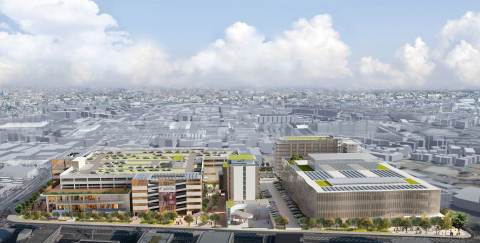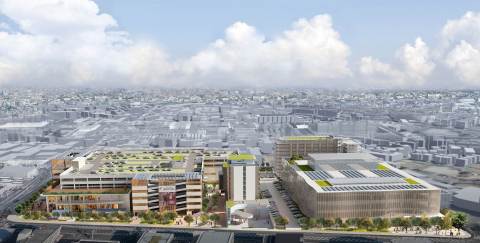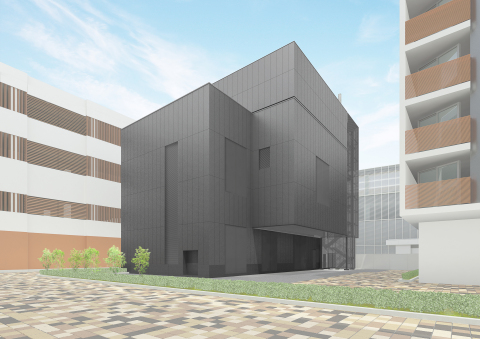OSAKA & TOKYO & YOKOHAMA, Japan--(BUSINESS WIRE)--The Tsunashima Sustainable Smart Town (SST) Council and its lead organizers, Panasonic Corporation and Nomura Real Estate Development Co., Ltd., today revealed a concept plan that guides the development of a new smart town they plan to build in Tsunashima in the City of Yokohama, southwest of Tokyo.
The Tsunashima SST Council, a consortium of ten organizations that promotes the development of the Tsunashima SST, created a Town Development Concept. The concept plan sets forth the town’s environmental targets, safety and security goals, and rules for the landscapes and operations, seeking to create a town where the participants from different industries collaborate in harmony to achieve the goals. Yokohama City will support the Tsunashima SST project as the city pushes forward its efforts as a “FutureCity,” a model city selected by the Japanese government to address common challenges including the environment.
The Tsunashima SST, at the site of a former Panasonic factory, consists of residential and non-residential facilities. Under the concept of “Innovating the Future Together,” private enterprises and the local government involved aim for an urban smart city, fostering innovations by exploiting synergies among progressive knowledge, technology and services. They also envision a town that brings together people who want a better future and makes their interactions part of a global network. The Town Development Concept has set targets for this urban smart city, including numerical goals, such as a 40% reduction of CO2 emissions (based on the levels in the fiscal year ended on March 31, 2006) and usage rates of 30% or higher for new energies1. Notably, it also stipulates the rules to manage the town’s landscapes and design, and those to help realize sustainable and comfortable lifestyles, as well as smart services, to ensure the town operates with unity and harmony as a whole.
The new forward-looking town will have a town energy center, a hydrogen refueling station and an international student dormitory. Tokyo Gas Group will install a gas cogeneration system in the town energy center, from which electricity and thermal energy produced by the system will be provided to other facilities. JX Nippon Oil & Energy Corporation will be involved in operating a refueling station of hydrogen, which is considered as the next-generation energy source, and promote hydrogen supply to fuel-cell vehicles as well as other initiatives toward a future hydrogen-based society. Keio University will open an international student dormitory designed to realize active international exchanges and collaboration with the local community through mechanisms encouraging student-led activities and practical efforts by researchers.
Supported by Yokohama City, the Tsunashima SST Council will contribute to the wide-area town development spanning from Tsunashima and bordering Hiyoshi, seeking to achieve sustainable lifestyles, towns, and societies.
Panasonic will strive to create more value from space and location by combining in-house and outside knowledge and technology through the company’s CRE solutions business, which, by utilizing idle land, aims to increase financial and business values and make contributions to the community.
Nomura Real Estate will develop a sustainable and attractive urban town by promoting its Hiyoshi Complex Development Plan that involves a 56,000 square meter site at 2-chome, Minowa Town, Kohoku Ward and linking this with the Tsunashima SST in the same ward.
Yokohama City supports this smart town project as a FutureCity, and will actively promote the development of a town that takes advantage of the potential of the Tsunashima and Hiyoshi areas.
Tsunashima SST Council
With the City of Yokohama as an
observer, the council, established in December 2015, consists of
enterprises and organizations that promote the development of the
Tsunashima SST, with the aim to open the town in 2018. PanaHome
Corporation will be involved in the development of the town management
center and the international student dormitory. Obayashi Corporation
will serve as a technical advisor.
| Lead organizers | Panasonic Corporation, Nomura Real Estate Development Co., Ltd. | |
| Organizers | MID Urban Development Co., Ltd.,* UNY Co., Ltd., Apple | |
| Council members | JX Nippon Oil & Energy Corporation, PanaHome Corporation | |
| Advisors | Keio University, Obayashi Corporation, Tokyo Gas Co., Ltd. | |
* MID Urban Development Co., Ltd. which will be renamed Kanden Realty & Development Co., Ltd., effective April 1, 2016. It will develop collective housing as a partner of Nomura Real Estate.
|
Overview of the Town Development Plan |
||||
| Concept | Innovating the Future Together. | |||
| Overall targets | Environmental targets |
• CO2 emissions: 40% reduction (vs. FY2005 ended March
31, 2006)
• Community water usage: 30% reduction (vs. FY2005) • Use of new energies1: 30% or greater |
||
| Safety targets | • CCP2: 3 days | |||
| Security targets |
• Town monitoring3: 100%
• Emergency services response time4: 15 minutes |
|||
| Three codes |
• Design code: Rules on designs and elements forming the landscape
of the town
• Sustainability code: Rules giving consideration to the next generation and the global environment • Smart code: Rules related to a convenient, comfortable, safe and secure lifestyle |
|||
| Smart services | Six smart services are planned: Energy, security, mobility, wellness, community and facility. These will help realize a sustainable smart life with people at the center, pursuing future lifestyles and comfort from the perspective of residents, working people, visitors and other people involved with the town. | |||
|
Notes: |
||
| 1. | Includes new technology such as natural gas cogeneration and fuel cells contributing to energy diversification with advanced utilization of new energy (for example, solar power generation) and innovative energy. | |
| 2. | Community Continuity Plan: Securing lifelines in case of emergencies. | |
| 3. | Secure town safety with 100% video coverage for the main entrances and exits. | |
| 4. | Shorten the time required to reach a location after the initial notification by use of systems and devices. There might be delay due to traffic conditions. | |
|
Tsunashima SST Overview |
||
| Name | Tsunashima Sustainable Smart Town | |
| Location | 4 Tsunashima-higashi, Kohoku Ward, Yokohama City, Kanagawa Prefecture | |
| Ground area | Approx. 37,900 m2 | |
| Overview |
Smart town management facility: Ground area approx. 3,500 m2
Smart collective housing: Ground area approx. 3,600 m2 Smart commercial facility: Ground area approx. 18,300 m2 Smart technology development facility: Ground area approx. 12,500 m2 |
|
| Schedule | Town opening in 2018 | |
Overview of the facilities and initiatives
1. Town
energy center (smart town management facility)
With a
view to realizing a smart energy network, this urban energy center is
located in the center of the city to provide the entire town with low
carbon energy, with disaster-resistant energy systems. The center
utilizes a high-efficiency gas cogeneration system using clean city gas
as its fuel. This cogeneration system efficiently utilizes heat produced
during power generation for cooling, heating, and hot water supply. Gas
supply utilizes highly earthquake-resistant medium-pressure gas
pipelines to help ensure lifelines to stay open even during disasters.
The center intends to be a rational model for area-wide interchange of
energy between compact complex town blocks.
2. Hydrogen refueling station (smart
town management facility)
The hydrogen service station
provides not only hydrogen but also information about hydrogen as a
communications hub to the community to lead a future hydrogen-based
society. The station supplies hydrogen safely to fuel cell vehicles by
adopting a hydrogen safety control system that integrates
earthquake-resistant design and various technologies including many
types of sensors. The adjoining showroom plainly introduces the features
of hydrogen and initiatives to make food use of it. Toward the future,
the Tsunashima SST is also considering supplying hydrogen to the fuel
cell systems for commercial use to generate electricity.
3. Town management center (smart town
management facility)
This center provides information on
community events inside the town, town energy, and evacuation if an
emergency occurs, acting as a management hub supporting and developing
life in this urban smart town. Plans currently under consideration for
the center include integrated control of security cameras overseeing the
town's safety and security, guided tours for business customers and
provision of office functions.
4. International student dormitory
(smart town management facility)
This international
student dormitory, which combines traditional Japanese culture and
advanced technologies, is designed to maximize values for students by
living and learning together. The dormitory will help foster
well-rounded internationally-oriented people for the future society
through events in the town and communication with the town residents. To
help communication among the students, there will be multi-signage
systems that let the students control for exchanging information and
interactions inside the dormitory; light controllers that can be adapted
to various situations according to the purpose the space is used for;
and space players that can enhance spaces through visuals. With security
systems and wide-area air purifiers that can remove viruses and
deodorize odor quickly, the dormitory will provide a safe, secure and
clean living environment to the students.
5. Smart commercial facility (UNY Co.,
Ltd.)
This is an environment-friendly next-generation
shopping center. This commercial facility aspires to become a new
flagship model of a food and health center for the smart town and the
surrounding area as well as serving as a center for activities to
cultivate the community. Advanced environmentally-friendly measures will
be put in this facility, including solar power generation and air
conditioning systems that run on waste heat from the town energy center.
There will also be Town Lockers where people can pick up products
ordered from online supermarkets. Introduction of some of the latest
systems is on the table. They include a multi-signage system that offers
diverse information not only about the store but also information on the
weather, disaster prevention and traffic, or evacuation guidance in
times of emergency; multifunction monitoring cameras that can provide
customer security and also can be used for marketing; and multilingual
translation systems for the increasing number of tourists. The objective
is to realize smart lives for customers while maintaining a sustainable
society and the store, by, for example, providing fresh and safe
vegetables grown with advanced environmental control technology.
6. Smart condominium (Nomura Real Estate
Co., Ltd. and MID Urban Development Co., Ltd.)
This
condominium will be a sustainable, next-generation housing suitable for
an urban type smart town. A system that combines energy creation and
storing features (solar panels and storage batteries) will be installed
in the common area, allowing for efficient use of renewable energy. When
linked with the elevators, this system enables them to work in case of
power outage. Each dwelling unit in the housing will have EneFarm
home-use fuel-cells and a Smart HEMS, providing a lifestyle in which
every resident will be able to live comfortably while leading an
ecological life that contributes to achieving a low-carbon society.
Regional cooperation
To keep a consistency with Yokohama
City’s Tsunashima and Hiyoshi area development, Tsunashima SST works in
tandem with the developers of Nomura Real Estate’s Hiyoshi Complex
Development Plan (tentative name) and the surrounding areas to build a
town that represents Yokohama, a FutureCity.






